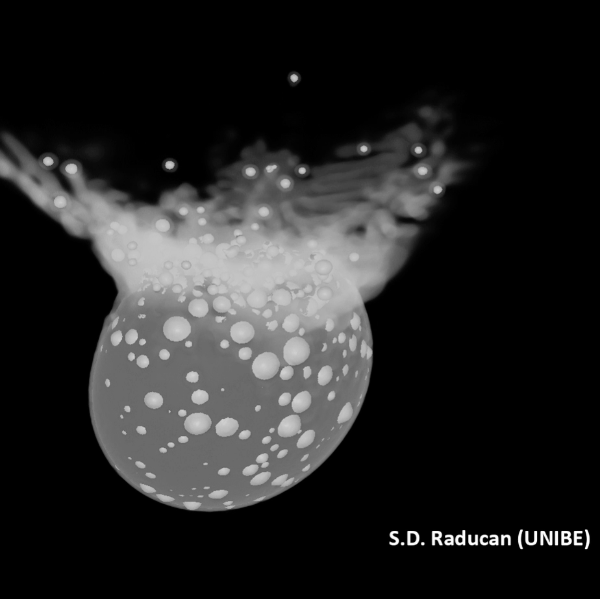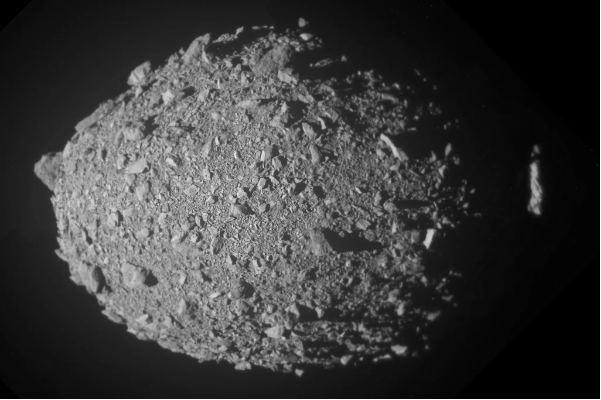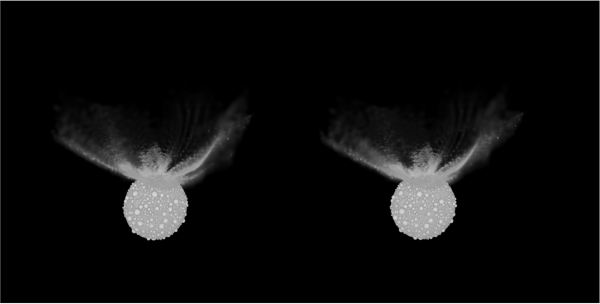Impact of the DART space probe could have deformed an asteroid

Thanks to simulations with a software system developed at the University of Bern by NCCR PlanetS members, an international team under Bernese leadership has provided important insights into the impact of NASA’s DART space probe on the asteroid Dimorphos: it is very likely that not just a crater was created, but the entire asteroid was reshaped. The ESA space probe Hera, which is currently being prepared for its journey to Dimorphos, will bring certainty. The simulations will also provide valuable insights for the defense of planet Earth.
ESA’s Hera spacecraft for planetary defence is being prepared for a journey to the distant asteroid moon Dimorphos orbiting around its parent body Didymos. One of the first features Hera will look for is the crater left on Dimorphos by its predecessor mission DART, which impacted the asteroid to deflect its orbit. Yet a new impact simulation study reported in Nature Astronomy suggests no crater will be found. The DART impact is likely to have remodelled the entire body instead – a significant finding for both asteroid science and planetary defence.
On 26 September 2022 NASA’s approximately half-tonne DART spacecraft impacted the boulder covered Dimorphos asteroid at a speed of 6.1 km/s .

A view of the asteroid Dimorphos made from 10 final full-frame images from the Direct Asteroid Redirect Test’s cameras seconds before impact on Sept. 26, 2022. © NASA/Johns Hopkins APL
This first experiment in the kinetic impact method of asteroid deflection was successful: observations from Earth show the 11 hour 55 minute orbit of Dimorphos around its parent asteroid Didymos was shortened by around 33 minutes (measured to an uncertainty level of plus or minus a minute).
What researchers still don’t know is how the asteroid as a whole reacted to the spacecraft impact, or the overall efficiency of momentum transfer. Calculating this latter ‘beta factor’ value requires precise knowledge of the asteroid’s mass which will be eventually measured by Hera.
Also needed to derive the beta factor is an accurate measurement of the recoil from material splashed back into space. For the time being tantalising clues have emerged, including images acquired by the Italian LICIACube nearby for up to five minutes and 20 seconds after DART hit, and images from the James Webb and Hubble Space Telescopes, as well as terrestrial telescopes. These all show a giant plume of debris that extended more than 10 000 km into space and persisted for months.
To get a close-up look at the post-impact Dimorphos, scientists will have to wait for the arrival of ESA’s Hera spacecraft. Due for launch this October, Hera will arrive at Dimorphos at the end of 2026, equipped with an array of instruments and supporting miniature ‘CubeSats’ to assess the make-up, structure and mass of Dimorphos, and reveal how the high-speed impact has transformed it (the very name Dimorphos comes from the Greek for ‘having two forms’).
In the meantime, an international research team has gained advance insight into DART’s impact by simulating it with the Bern Smoothed Particle Hydrodynamics (SPH) impact code. This software system, developed at the University of Bern over two decades, is designed to replicate the collisional breakup of rocky bodies.

A computer model simulated the DART spacecraft colliding with the asteroid Dimorphos. © Sabina Raducan
Bern SPH works by converting colliding bodies into millions of particles whose behaviour upon impact is determined by the interplay of various reconfigurable variables, such as the asteroid’s gravity, density or material strength. It has been validated by laboratory experiments and has also been used to reproduce one existing asteroid impact test – when Japan’s Hayabusa2 spacecraft slammed a small copper impactor into the Ryugu asteroid in 2019.
“The code runs on a High Performance Computing Cluster here at the University,” explains Sabina Raducan of the Space Research and Planetary Science, Physics Institute of the University of Bern, leading the team and co-chair of the Hera Impact Physics Working Group. She is also a member of the National Center of Competence in Research NCCR PlanetS, which is jointly managed by the University of Bern and the University of Geneva.
“This is a computationally intensive process, with each simulation taking around a week and a half to run, and we ran around 250 simulations overall, reproducing the first two hours after impact. We incorporated all the values we did know – such as the mass of the DART spacecraft, the approximate shape of the asteroid, the orbital deflection and the size of the impact plume – while varying the factors we don’t know, such as the closeness of packing of boulders, their density, the porosity of material and its overall cohesion. We also made some reasonable assumptions based on the physical properties of meteorites resembling Dimorphos.
“Then what we did is check which of the simulation run outcomes most closely match observed reality. The results indicate that Dimorphos is a relatively weak ‘rubble pile’ asteroid, held together by the asteroid’s extremely weak gravity rather than cohesive strength. This helps to account for the unexpectedly high efficiency of DART’s orbital deflection.”
To understand cohesion in everyday life, think about pouring a stream of flour as opposed to sand. Falling grains of flour will form into a high-angled conical shape because of their greater cohesive strength, while sand will end up making a much flatter heap.
“A cratering event is normally concluded by either the force of gravity or the strength of the material being cratered,” adds Martin Jutzi from the University of Bern, also co-chairing Hera Impact Physics Working Group. “On Earth the force of gravity is such that cratering occurs briefly, producing a typical cratering cone angle of around 90 degrees. What we saw with DART’s impact of Dimorphos was a much wider ejecta cone angle extending by up to 160 degrees, influenced mainly by the curved shape of the asteroid’s surface. And the crater kept on expanding, because both the gravity and material cohesion is so low.”
Sabina adds: “The likelihood is that the crater grew to encompass the entire body itself, so that Dimorphos ended up being completely reshaped. As a consequence, Hera will probably not be able to find any crater left by DART. What it will discover instead will be a very different body. Our simulations suggest that Dimorphos has had its initial flying saucer shape blunted on its impact side: if you think of Dimorphos as starting out as resembling a chocolate M&M, now it would look like it has had a bite taken out of it!”
This change will also have had consequences for Dimorphos’s orbit around its Didymos parent. To help interpret the results of the simulated reshaping, the team made use of stereoscopic images prepared by Queen guitarist and astrophysicist Sir Brian May with his collaborator Claudia Manzoni.
This prolonged cratering event increased the efficiency of the deflection considerably; the team estimates that 1% of the entire mass of Dimorphos was thrown into space by DART’s impact, thanks to its low escape velocity of just 10 cm/s. And around 8% of the asteroid’s mass was shifted around its body.
And if Dimorphos is a rubble pile – hanging in orbit more like a bunch of grapes, rather than a solid monolith – then this finding also has important consequences for the body’s likely origin. It strengthens the hypothesis that the moonlet was formed by a past ‘spin-up’ of its parent flinging equatorial material into space that later coalesced together due to gravity.

Observation and simulation of DART’s impact on Dimorphos. (A, B) This high-resolution image of Dimorphos and impact ejecta, at 178 seconds after DART’s impact, was taken by the Italian spacecraft LICIACube and is compared with our simulation (C) of the DART impact into a cohesionless (Y0= 0 Pa), rubble-pile target, at the equivalent time. © Sabina Raducan
“The big picture we end up, of Dimorphos as an almost cohesionless body shaped largely by the weak force of gravity, does seem to agree with our up-close observations of other asteroids,” notes Patrick Michel Director of de Research at CNRS at the Observatoire de la Côte d’Azur in Nice and Hera’s Principal Investigator. “Ryugu – visited by Hayabusa2 – and Bennu – visited by NASA’s OSIRIS-Rex spacecraft – are carbon rich ‘C-class’ asteroids, very different from the silicate-rich ‘S-class’ Didymos and Dimorphos, but all of them do seem to possess a comparable lack of cohesion. We still need to understand and clarify this behaviour, because we cannot make statistics on only a trio of asteroids, but a general lack of cohesion for all small asteroids is an intriguing suggestion, and would be good news for planetary defence, because if we know in advance how a body will react, this will make it easier to design the appropriate deflection tools!”
Hailing from 24 institutions in all, the team forms part of the larger international Hera Science Working Group. They are looking forward to finding out if their colleagues’ latest observations of the Didymos system validate aspects of their modelling, such as the altered asteroid shape and resulting orbital perturbations, which will eventually be fully made clear by Hera.
Categories: News

